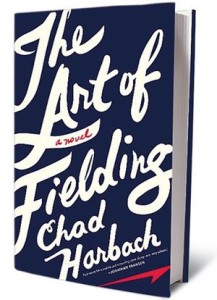 In his novel, “The Art of Fielding,” Chad Harbaugh writes about the work of the shortstop.
In his novel, “The Art of Fielding,” Chad Harbaugh writes about the work of the shortstop.
- “Rule 3: There are three stages: Thoughtless being. Thought. Return to thoughtless being.”
- “Rule 33: Do not confuse the first and third stages. Thoughtless being is attained by everyone, the return to thoughtless being by a very few.”
This fictional philosophical proposition describes a moment I enjoy watching whenever I attend a major league baseball game. It’s a moment many others in the stadium don’t even notice. At different times during the game I focus on individual players to see how each one “readies himself” before the pitch.
Between pitches each player on the field appears relaxed, even lazy. Some players are looking around and in the stands, others are smoothing the dirt around them with their cleats, at least one is spitting into his glove and then rubbing it. Covertly they may also be flashing signs to each other about the next pitch, a pick-off play, or signaling to each other to adjust their position right or left, forward or back.
 But then the pitcher goes into his windup. The moment before he delivers the pitch, each infielder assumes his own version of readiness. His knees bent, his feet apart and ready to move either direction, his glove open and in the position to receive the ball. Each player is fully ready for what may come. Once the pitch is thrown, each player relaxes again. This happens pitch after pitch after pitch.
But then the pitcher goes into his windup. The moment before he delivers the pitch, each infielder assumes his own version of readiness. His knees bent, his feet apart and ready to move either direction, his glove open and in the position to receive the ball. Each player is fully ready for what may come. Once the pitch is thrown, each player relaxes again. This happens pitch after pitch after pitch.
Achieving that state of readiness when the pitch is thrown is crucial, but no player can sustain that kind of physical and mental attention throughout the game, or even for an inning. Returning to that state of physical and mental relaxation before the next pitch and that next moment of readiness is equally important.
None of us can sustain that kind of attention, no matter what the activity. Whether we are in the office, the kitchen, or pushing the mower, life requires that movement from relaxation to readiness and back to relaxation. Depending on the activity, that movement through the three stages varies in length and frequency.
 As a psychotherapist, my days were frequently chopped up in 50 minutes of attention followed by 10 minutes of relaxation. Yet, even in those 50 minutes, my vigilance increased and decreased based on what the other person was saying, on their intensity, and on my own fatigue at the time. Interestingly, during my work for a bricklayer many years ago, I observed the same attention and inattention in the course of their day. Much of their work was repetitive and seemed mindless to me. But it required periodic vigilance to make sure the wall was vertical and each row was horizontal according to the specs.
As a psychotherapist, my days were frequently chopped up in 50 minutes of attention followed by 10 minutes of relaxation. Yet, even in those 50 minutes, my vigilance increased and decreased based on what the other person was saying, on their intensity, and on my own fatigue at the time. Interestingly, during my work for a bricklayer many years ago, I observed the same attention and inattention in the course of their day. Much of their work was repetitive and seemed mindless to me. But it required periodic vigilance to make sure the wall was vertical and each row was horizontal according to the specs.
Those periods in my life when I have been most stressed, distracted, anxious, and least productive have been those times when I could not “return to thoughtless being.” Finding ways of being mindful of that ebb and flow, of “returning to thoughtless being” is crucial in today’s world that is constantly clamoring for our undivided attention.
0 Comments until now
Add your Comment!